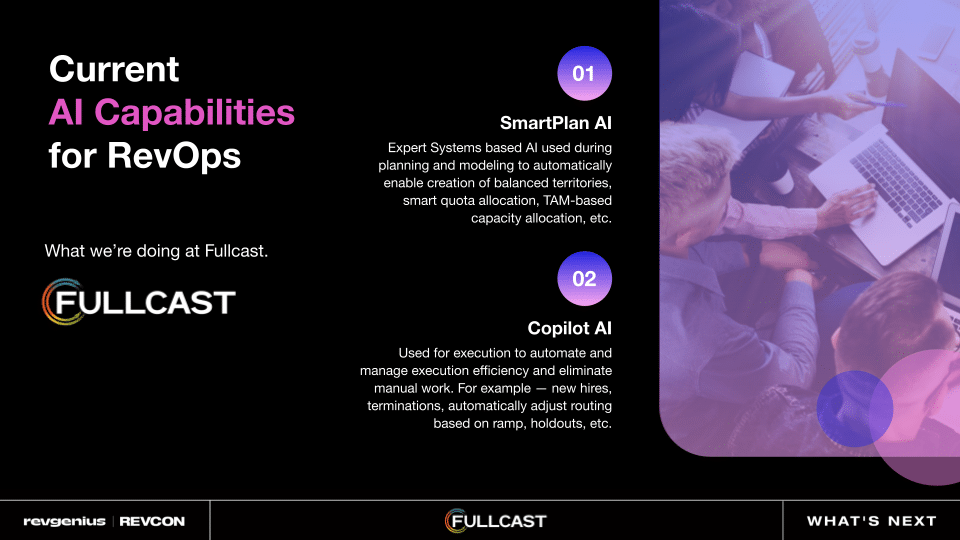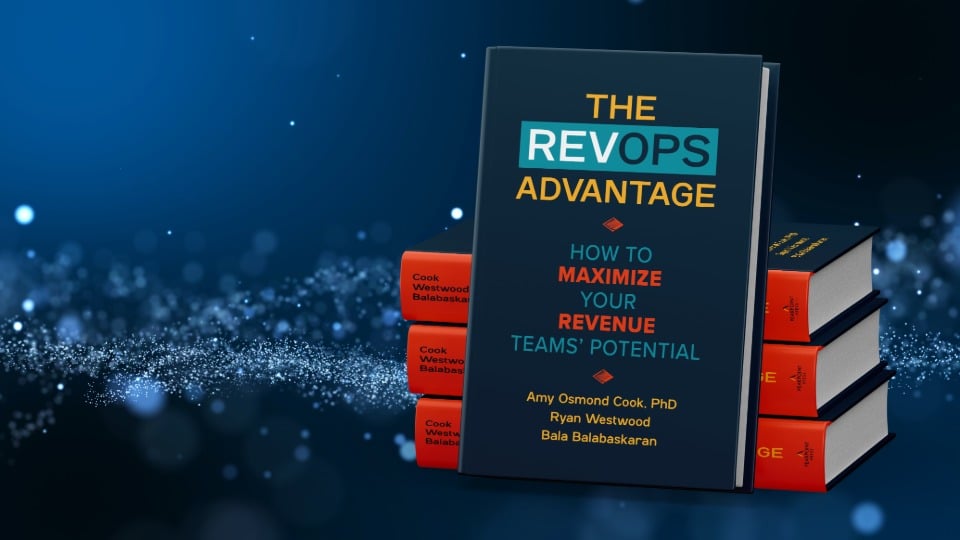Will emerging AI innovations impact your job next year?
That is what Bala Balabaskaram, co-founder and CTO at Fullcast, and Amy Cook, co-founder and CMO, asked during their RevCon keynote address.
Ninety-one percent of the audience believes it will, and Amy and Bala agree.
As RevOps professionals, they have already seen the challenges and opportunities of incorporating AI innovation, especially in a Go-to-Market partnership. With increasing customer expectations, ambitious sales quotas, expanding revenue-building initiatives, and a new form of automation encroaching on every aspect of business operations, what IS the strategic role of RevOps in the revenue cycle, and how can we prepare for our place in the RevOps community?
Understanding The Strategic Role of RevOps in the Revenue Cycle
RevOps plays a pivotal role in team alignment by seamlessly integrating sales, marketing, and customer success teams across the revenue cycle.
RevOps leaders exercise a deep, holistic understanding of operations, leveraging their comprehensive knowledge of systems, data, and processes to provide unbiased guidance that drives growth. Their unique perspective allows them to identify opportunities and inefficiencies that others might miss, making them invaluable in optimizing revenue streams.
As strategic advisors, their expertise profoundly influences decision-making, helping companies navigate the evolving revenue landscape with agility and precision.
By aligning teams and offering insightful advice, RevOps leaders ensure that every department works harmoniously toward the common goal of sustained growth and success.
Preparing for the RevOps Community
Adopt a Future-Ready Mindset
This means embracing automation as a relevant, strategic tool. If you’re not using AI, your job is at risk of being replaced with automation. However, this creates a unique dichotomy from a marketing perspective.
“On one hand, you see all of these new companies automating conversations and pushing out content,” Amy observed. “On the other hand, you see Google and Microsoft downgrading all of the automated emails to SPAM and reducing website ratings if there is AI content.”
The Fullcast marketing team finds balance by using AI for quick topic references or outlines to work faster and lighten the workload. “But the human aspect of it, we will never ever give up,” Amy said. “Because business is about people, and that will never change.”
Focus on Functional Alignment
Amy and Bala often face questions on how to drive automation in your outreach that targets individuals and is hyper-customized to the message GTM wants to deliver.
“Well, to do that effectively, you really have to break down silos between sales, marketing and customer success because they all have to work together in a common plan,” Bala explained. “Systems that don’t talk to each other are going to hinder your ability to evolve the organization in that direction.”
Studies show 81% of Generative AI users say this technology has improved productivity, and 43% reported it significantly improved it.
Use AI to Drive Predictability
With a unified view of the entire customer journey, RevOps leaders use AI to ensure more predictable revenue streams and quicker adjustments to market changes.
Bala admits his job was transformed by AI early on. Bring it! As far as he’s concerned. As a pioneer of the early stages of Salesforce RevOps, Bala remembers distributing 1500 spreadsheets among his managers to navigate sales strategies.
“None of my team was happy with their jobs because, as you can imagine, it was crazy stressful,” Bala recalled. That was just the beginning of the struggles.
“Once you roll out all the plans, which took us a couple of months after the start of the fiscal year to organize the moves and changes, the daily business of running RevOps sort of catches up with you.”
That’s when Bala realized the transformational potential of automation for revenue operations.
“I think after that, realizing and learning from that experience is sort of what led to us creating Fullcast and really focusing in on that problem of helping the RevOps teams, who are really the unsung heroes, behind the scenes, who are making all of these things work to enable a smooth running RevOps organization.”
Fullcast has two RevOps offerings: the SmartPlan AI and CopilotAI.
Meet Fullcast’s Current AI Capabilities for RevOps
How do you accelerate the planning process from a once-a-year exercise to something that can be done continuously to keep pace with a changing market?
From a Fullcast perspective, Bala explained that we’ve focused on two aspects of a RevOps function: the planning side and the execution. Meet SmartPlanAI and CopilotAI.
SmartPlan AI
One exciting thing to watch with AI is this evolution from pure automation and machine learning-type use cases to generative AI, LLM, and agentic interfaces. Now, the direction is headed toward autonomous AI agents. AI drives this idea of organizational intelligence.
“In the past 12 months we’ve seen people talk about organizational general intelligence and now you have to be thinking about the role of RevOps person changing,” Bala said. “How can we deploy AI in an effective way?”
RevOps leaders can use this expert systems-based AI platform to automatically create balanced territories, smart quota allocation, TAM-based capacity allocation, and more for agile planning and modeling.
Once RevOps leaders get the plan going, how can they execute it? How do they keep day-to-day activity in the environment aligned with the plan? CopilotAI.
CopilotAI
CopilotAI helps accelerate plan deployment mainly by eliminating redundant administrative tasks often accompanying a changing environment, such as staff changes, and automatically adjusts routing based on ramp, holdouts, and more.
It’s important for RevOps professionals to be ahead of the curve. As automation builds itself into the various agency platforms, it’s also important for us to stay ahead in terms of its operational aspects to deploy AI effectively in organizations.
What does an AI strategy look like for RevOps Leaders?
Focus on agility as your goal. “For me, that’s what gives you the superpower as a function within the organization,” Bala said. “It’s what’s going to drive ROI.”

























